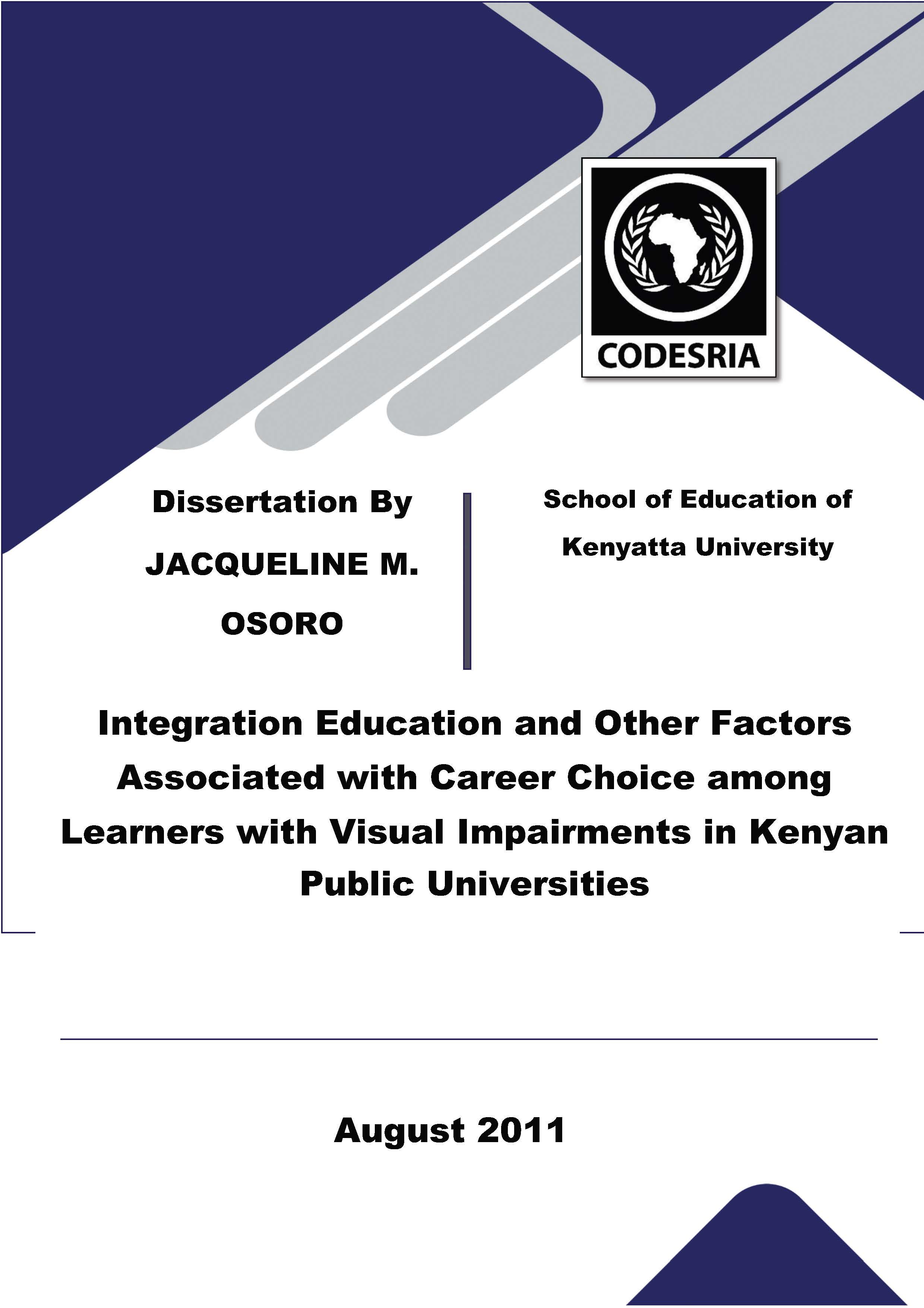Integration Education and Other Factors Associated with Career Choice among Learners with Visual Impairments in Kenyan Public Universities
Keywords:
Disabled students, universities, occupational choice, integrated curriculum, visual impairment, KenyaSynopsis
Learners with visual impairments need to choose careers that will later determine
their productivity in society. The purpose of this study was to therefore find out how
career choice of learners with visual impairment in selected Kenyan Public
Universities were affected by the practice of integration education among other
factors. Its objectives were; to find out how career choices of visually impaired
learners were affected by the current practice of integration education and training in
Kenya, to find out career choices that were being undertaken by them and to identify
other factors that determined their career choice. The study was carried out in two
public universities in Kenya, namely Kenyatta University and Moi University. The
target population of the study consisted of visually impaired learners in public
universities in Kenya. A total of forty one learners with visual impairments were
selected as respondents for the study. The researcher used purposive sampling
procedure. Two types of research instruments were used in this study i.e. interview
schedules and focused group discussions (FGDs). Both qualitative and quantitative
techniques were used to analyze data that was generated for the study. Data collected
was presented in frequency di.stributions and percentages. To identify relationships
between different variables; the chi-square analysis was employed. Qualitative data
was presented in form of themes. It was found that integration education did not
influence the. career choices of learners with visual impairments despite having
several benefits. It was also found that most learners with visual impairments were
pursuing teaching as a career. However, most of them were not pursuing their
preferred careers. It was found that gender, environment in which one was brought
up, parental education, parental occupation and the type of education system attended
did not affect the choices of careers of these learners. However, the level of education
of siblings and the mode of admission that is either self sponsored or government
sponsored seemed to have had a significant influence on their career choices. The
study further revealed that the major factors that contributed to the choice of careers
included interest, salary, parental motivation and social influence which positively
affected the learners' career choices. Other factors such as visual limitation, lack of
appropriate technology, academic performance and lack of career awareness
negatively affected the career choices. It was recommended that the Government
develops a policy that fully embraces integration education. The Joint Admissions
Board (JAB) should consider lowering the cut-off points which will in turn allow
more visually impaired learners to access higher education. It was recommended that
career education be introduced in all schools. This will give the learners with visual
impairment a wide range of experiences on various careers and enable them make
wiser career·choices.
Downloads
References
ACT. (2005), Courses count: Preparing Students for Postsecondary Success. Iowa City, IA
ACT. (2007). The Role of Non-Academic Factors in College Readiness and Success. Iowa City, IA
Akatsa, O.G. (1986). Special Education in Kenya. A case of St. Catherine School for Mentally Retarded (Unpublished Master's Thesis). Kenyatta University, Nairobi, Kenya
Allen, R.E. 200 I .The Oxford Dictionary of Current English (8th Ed.). New York: 'Oxford University fress.
Alberts, C., Mbalo, N. F., & Ackermann, C. J.(2003). 'Adolescents' Perceptions of the Relevance of Domains of Identity Formation: South African Cross-Cultural .Study', Journal of Youth and Adolescence 32 (3), 169-184.
American Foundation for the Blind, (2009). Careers for Blind and Visually Impaired Individuals: Article retrieved October 26, 2009 from www.afb.org
Anderson, R., Mawby, R.A, Miller, J.A, & Olson, A. (1965). Parental Aspirations: A key to the Educational Achieve~_ents of Youth. Adult Leadership, 14, 8-10.
Andres, J. (2006). Special Education in Chile. New York: Oxford University Press.
Arsenovic, s.; Timothy, S., & Zoleko, G. (2005). Influences on Adolescent Females 'Career Aspirations: Home versus Public Schooling.
Symposium conducted at Goshen College, Goshen, Indiana.
Austin, J. T., & Hanisch, K. A. (1990). Occupational Attainment as a Function of Abilities and Interests: A Longitudinal Analysis Using Project TALENT data. Applied Psychology, 75, 77-86.






